The Bioelectric Medicine Market is estimated to be valued at USD 25.9 billion in 2025 and is projected to reach USD 46.8 billion by 2035, registering a compound annual growth rate (CAGR) of 6.1% over the forecast period.
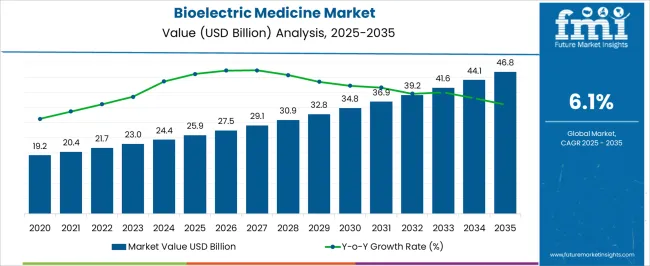
| Metric | Value |
|---|---|
| Bioelectric Medicine Market Estimated Value in (2025 E) | USD 25.9 billion |
| Bioelectric Medicine Market Forecast Value in (2035 F) | USD 46.8 billion |
| Forecast CAGR (2025 to 2035) | 6.1% |
The Bioelectric Medicine market is experiencing strong expansion, supported by the rising prevalence of chronic diseases and the growing adoption of advanced implantable devices that modulate nerve activity for therapeutic benefits. Increasing incidence of cardiovascular disorders, neurological conditions, and metabolic diseases has heightened the demand for bioelectric therapies as alternatives or complements to conventional pharmaceutical treatments. The development of miniaturized devices, integration of wireless communication, and advances in battery technologies are extending the life cycle and functionality of medical implants, making them more reliable and patient-friendly.
Regulatory approvals and clinical trials are further validating the effectiveness of bioelectric interventions, encouraging broader adoption in clinical practice. In addition, healthcare systems are increasingly focusing on cost efficiency, and bioelectric devices, with their potential to reduce long-term medication dependency, are emerging as valuable solutions.
Growing investments in research and development, coupled with expanding applications beyond cardiology into pain management, diabetes control, and inflammatory diseases, are shaping future opportunities As awareness of non-invasive and implantable bioelectronic treatments continues to rise, the market is positioned for sustained growth, driven by technological innovation and increased clinical adoption.
The bioelectric medicine market is segmented by device type, product type, application, end user, and geographic regions. By device type, bioelectric medicine market is divided into Implantable and Non Implantable. In terms of product type, bioelectric medicine market is classified into Defibrillators, Pacemakers, Stimulators, Spinal Cord Stimulators, Deep Brain Stimulators, Vagus Nerve Stimulators, Sacral Nerve Stimulators, Others, Implants, Retinal Implants, and Cochlear Implants. Based on application, bioelectric medicine market is segmented into Arrhythmia, Chronic Pain, Parkinson’s Disease, Epilepsy, Urinary Incontinence, Menstrual Migraine, Fecal Incontinence, Retinitis Pigmentosa, Depression, Spinal Cord Injury, Obesity, and Others. By end user, bioelectric medicine market is segmented into Hospitals, Ambulatory Surgical Centers, Specialty Clinics, Home Care Settings, and Other. Regionally, the bioelectric medicine industry is classified into North America, Latin America, Western Europe, Eastern Europe, Balkan & Baltic Countries, Russia & Belarus, Central Asia, East Asia, South Asia & Pacific, and the Middle East & Africa.
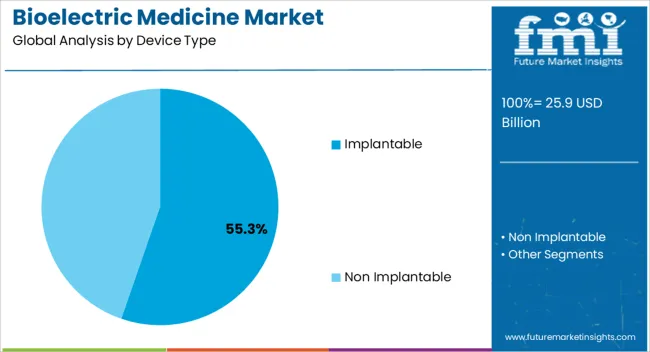
The implantable device type segment is expected to capture 55.3% of the Bioelectric Medicine market’s revenue in 2025, establishing its position as the leading device type. Growth in this segment is driven by the proven effectiveness of implantable devices in delivering targeted stimulation for chronic conditions, particularly in cardiology and neurology. These devices are preferred for their ability to provide consistent, long-term therapeutic effects with minimal intervention once implanted.
Advances in materials science, wireless recharging, and miniaturization are enhancing the safety, comfort, and durability of these devices, which is strengthening patient acceptance. Implantable devices also provide physicians with advanced monitoring capabilities and programmable settings, allowing for personalized treatment regimens. The growing prevalence of arrhythmia, Parkinson’s disease, and epilepsy has further reinforced demand.
Additionally, supportive reimbursement frameworks in developed markets are boosting adoption rates As the technology continues to evolve with smarter sensors and AI integration, the implantable device type is expected to maintain its leadership, driven by its unmatched ability to address severe and persistent medical conditions effectively.
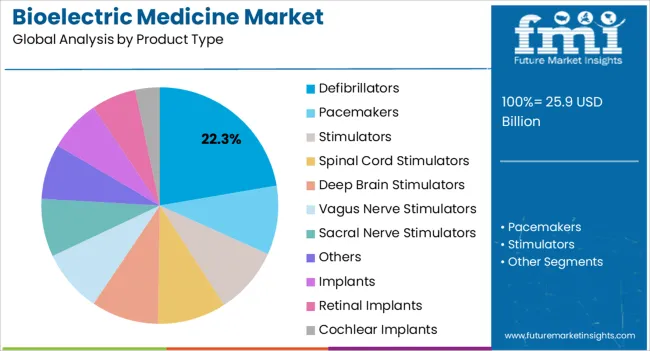
The defibrillators product type segment is projected to hold 22.3% of the market’s revenue in 2025, making it the dominant product category. The segment’s growth is closely linked to the rising global burden of cardiovascular diseases, particularly sudden cardiac arrest, where defibrillators play a critical life-saving role. Implantable cardioverter defibrillators and external defibrillators are increasingly being adopted in hospitals, emergency response systems, and home care settings.
Advancements in portability, automation, and connectivity are making defibrillators more accessible and user-friendly, reducing response times and improving survival outcomes. Regulatory approvals and clinical studies supporting their effectiveness in high-risk patients are strengthening confidence in adoption. Additionally, initiatives promoting public access defibrillator programs in airports, workplaces, and educational institutions are accelerating market penetration.
The integration of AI-driven predictive analytics and cloud connectivity for remote monitoring is further enhancing efficiency As cardiovascular disease incidence continues to rise globally, the defibrillators product type is expected to remain central to treatment protocols, ensuring its leadership position within the market.
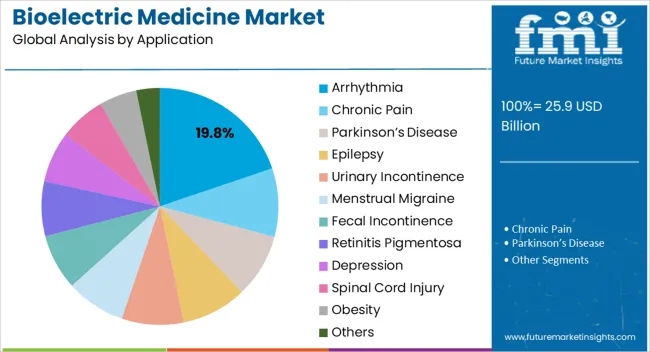
The arrhythmia application segment is anticipated to account for 19.8% of the Bioelectric Medicine market’s revenue in 2025, making it the leading application area. The rising prevalence of irregular heart rhythms, driven by aging populations and lifestyle-related risk factors, has created strong demand for bioelectric therapies. Devices such as pacemakers and defibrillators are being widely adopted for arrhythmia management due to their proven ability to restore normal cardiac rhythm and prevent sudden cardiac death.
Continuous innovation in device design, including leadless pacemakers and MRI-compatible implants, is further driving patient and physician acceptance. Remote monitoring features are enabling better management of chronic arrhythmia patients, reducing hospital visits and improving long-term outcomes. Favorable reimbursement policies and government initiatives aimed at strengthening cardiac care infrastructure are accelerating adoption in both developed and emerging markets.
As healthcare providers emphasize preventive and precision medicine, bioelectric devices are playing a central role in arrhythmia treatment strategies The segment is expected to maintain its dominant position, supported by technological advancements and the persistent global burden of cardiac disorders.
Technology is changing the world and bioelectric medicine is fore front of technological revolution in medical sciences. The pharmaceutical industry’s history is based on therapies that target molecular mechanism. Bioelectric medicine has different treatment therapy that is based on electrical pulses instead of drugs to trigger the body.
Bioelectric medicine develops nerve stimulating and sensors activation technologies to regulate biological functions and treat diseases by combining bioengineering, neuroscience, molecular medicines, electronics and computing these technologies may change the future of therapies for wide range of diseases. Bioelectric medicine act through targeted mechanism of action to treat diseases.
Though the concept of using bioelectric medicines to treat the patient has been around decades, technological advancements are driving the market to grow in near future. Bioelectric medicine is the field where devices are made to treat various kind of diseases like rheumatoid arthritis, diabetes, paralysis and cancer as well.
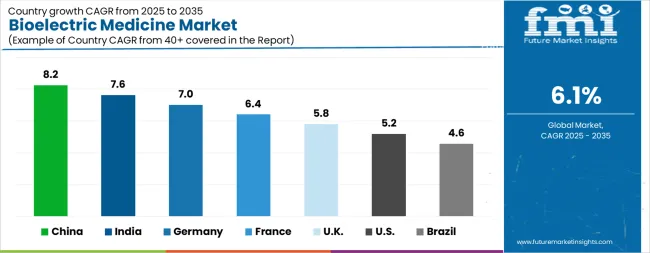
| Country | CAGR |
|---|---|
| China | 8.2% |
| India | 7.6% |
| Germany | 7.0% |
| France | 6.4% |
| UK | 5.8% |
| USA | 5.2% |
| Brazil | 4.6% |
The Bioelectric Medicine Market is expected to register a CAGR of 6.1% during the forecast period, exhibiting varied country level momentum. China leads with the highest CAGR of 8.2%, followed by India at 7.6%. Developed markets such as Germany, France, and the UK continue to expand steadily, while the USA is likely to grow at consistent rates. Brazil posts the lowest CAGR at 4.6%, yet still underscores a broadly positive trajectory for the global Bioelectric Medicine Market. In 2024, Germany held a dominant revenue in the Western Europe market and is expected to grow with a CAGR of 7.0%. The USA Bioelectric Medicine Market is estimated to be valued at USD 9.7 billion in 2025 and is anticipated to reach a valuation of USD 16.0 billion by 2035. Sales are projected to rise at a CAGR of 5.2% over the forecast period between 2025 and 2035. While Japan and South Korea markets are estimated to be valued at USD 1.4 billion and USD 652.5 million respectively in 2025.
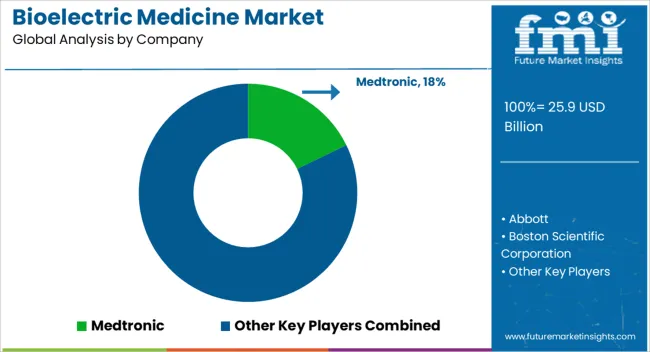
| Item | Value |
|---|---|
| Quantitative Units | USD 25.9 Billion |
| Device Type | Implantable and Non Implantable |
| Product Type | Defibrillators, Pacemakers, Stimulators, Spinal Cord Stimulators, Deep Brain Stimulators, Vagus Nerve Stimulators, Sacral Nerve Stimulators, Others, Implants, Retinal Implants, and Cochlear Implants |
| Application | Arrhythmia, Chronic Pain, Parkinson’s Disease, Epilepsy, Urinary Incontinence, Menstrual Migraine, Fecal Incontinence, Retinitis Pigmentosa, Depression, Spinal Cord Injury, Obesity, and Others |
| End User | Hospitals, Ambulatory Surgical Centers, Specialty Clinics, Home Care Settings, and Other |
| Regions Covered | North America, Europe, Asia-Pacific, Latin America, Middle East & Africa |
| Country Covered | United States, Canada, Germany, France, United Kingdom, China, Japan, India, Brazil, South Africa |
| Key Companies Profiled | Medtronic, Abbott, Boston Scientific Corporation, Cochlear Ltd., LivaNova PLC, Biotronik SE & Co. KG, electroCore, Inc., Sonova, Nevro Corp., and Stimwave LLC |
The global bioelectric medicine market is estimated to be valued at USD 25.9 billion in 2025.
The market size for the bioelectric medicine market is projected to reach USD 46.8 billion by 2035.
The bioelectric medicine market is expected to grow at a 6.1% CAGR between 2025 and 2035.
The key product types in bioelectric medicine market are implantable and non implantable.
In terms of product type, defibrillators segment to command 22.3% share in the bioelectric medicine market in 2025.
Explore Similar Insights

Thank you!
You will receive an email from our Business Development Manager. Please be sure to check your SPAM/JUNK folder too.
Chat With
MaRIA